What's on your workbench, January 2020?
123




















123
Re: What's on your workbench, January 2020? Early Cooke 2-6-0 paint schemes
|
These early paint schemes are very interesting to me too. Both Derrell's and Mike's interpretations produced really beautiful engines, and I don't want to argue with anything that has been said about colors.
I would like to add a point having to do with the reflectivity question. Whether the surface is very glossy or a dull, matte surface texture can make huge differences in the brightness in an image, and depends strongly on the angle of illumination and the resulting reflection of light. A matte finish never looks entirely black because it scatters some reflected light in all directions, whereas a smooth, glossy finish looks very black or very bright, depending on whether or not it is reflecting light like a mirror directed at the viewer. I notice that in the first of Jim's photos of #8, the tender looks much lighter than the loco's cab, and about the same grey tone as the coach behind it. Likewise with the third photo of #9 at Pitkin. I don't think anyone is advocating color other than black for tenders, and this to me argues for a dull (or just very uniformly dirty??) black paint on the tenders and a very glossy smooth black finish on the cabs. Those glossy finishes look very bright in the reflections seen on the boilers and curved surfaces of the domes that reflect the sky light to the camera in these photos. It's really hard to tell whether the straight cylindrical sides of the domes are actually a different color, they look very black because they aren't reflecting the skylight to the camera. But in any case, whatever color is chosen for those parts, green (which I really like) or black, I think it should be a glossy finish. It does seem to me that the engines look cleaner in many early photos than in later years and maybe they did wash them more often, but I bet the difference is probably mostly because of polished glossy surfaces in the early years. John
John Greenly
Lansing, NY |
Re: What's on your workbench, January 2020?
|
In reply to this post by Jim Courtney
Ah, yes, those beautiful S scale gold intertwined "columbine" decals that Jim showed in his post! I need some in HO scale for my engines #22 and #30. I got in touch with Bill Meredith at Leadville designs. He will happily make some up. For my two engines with those numbers only it will be a quarter sheet size which is $25 to print, and he said it would take no more than an hour of his time at $50/ to do the scale reduction and layout. I wonder if anyone else might be interested in having some HO scale sets. If so, maybe we could join up, split the cost and save some money on both the work and the printing. For instance, a half-sheet print is $35 and presumably would fit four engines' requirements, and larger jobs would save yet more. Anyone interested?
John
John Greenly
Lansing, NY |
Re: What's on your workbench, January 2020?
|
My HO model of the Alpine Tunnel boarding house. Not quite complete, but making progress slowly but surely.
Joe 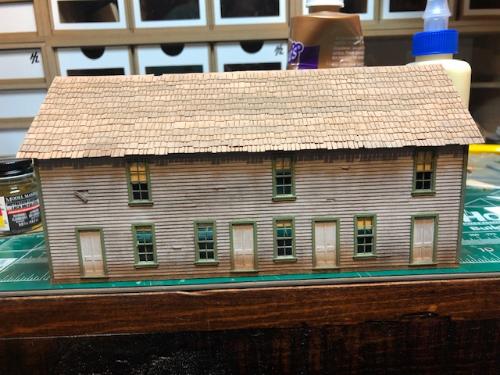
|
Re: What's on your workbench, January 2020?
|
Very nice!
|
Re: What's on your workbench, January 2020?
|
A quick update on 1008 assembly progress.
Since my last post more progress has been made. The frame is assembled and is being squared and I’m almost ready to tighten tension rods. I am preparing some of the attachments like spring hangers and brake hanger brackets and crash plates for the dead wood. Once those are in place pedestals, journal boxes springs and wheels. More later. Richard 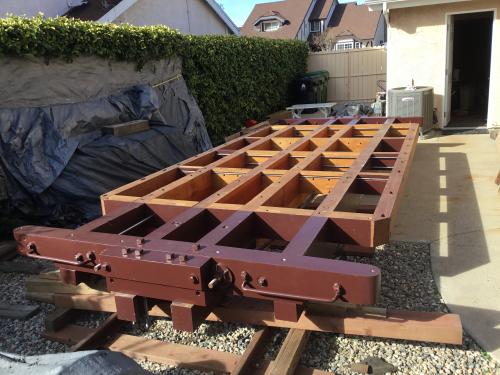 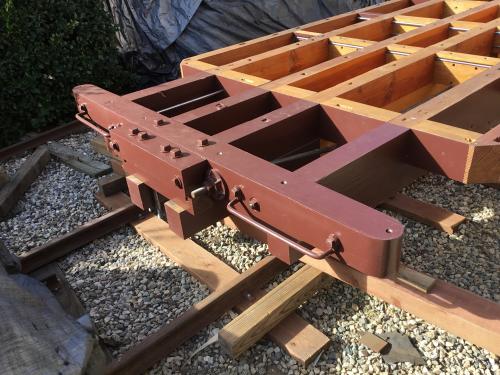 |
Re: What's on your workbench, January 2020?
|
Richard, what did you do to treat the wood before assembly ? Any sort of oiling
before the paint went on ? How about the raw areas ?
"Duty above all else except Honor"
|
Re: What's on your workbench, January 2020?
|
Hi South Park
What looks like bare wood has actually had two heavy coats of linseed oil, that includes in the mortise and on the tenons. On top of the linseed oil under the paint is a coat of oil based primer and then the paint. Most likely the whole thing will receive an additional coat of paint when we get closer to the finish line. I hope everyone is as happy as I am with the color. The color choice is the result of extensive research and physical analysis of the existing paint on the car. We are not planning on weathering the car but I’m sure Mother Nature will take care of that for us. Richard |
Re: What's on your workbench, January 2020?
|
Richard,
Such beautiful work! It's wonderful to see this caboose come to life again, and done in such a skillful, thorough and accurate way. thanks, John
John Greenly
Lansing, NY |
Re: What's on your workbench, January 2020?
|
Linseed oil was a popular wood preservative in the 19th century and
one I use a lot. In fact, spent the day today soaking it into a cabinet door. Did you thin it ? I mix mine down 50% with mineral spirits for deeper penetration and then apply as many coats as it takes to where it is not absorbing very well. It is a joy to watch your progress. You share my interest in modeling in full scale. Thanks for sharing.
"Duty above all else except Honor"
|
Re: What's on your workbench, February 2020
|
Did someone say "modelling in full scale"
 The mother of all Mining scenes .... 
UpSideDownC
in New Zealand |
Re: What's on your workbench, January 2020?
|
In reply to this post by South Park
We did thin with mineral spirits and added some Japan drier. As you know, it takes a long time for the linseed oil to set up to a point where it’s not really sticky and can be handled, the Japan really helped.
Thank you for your interest in our project. We do share your interest in modeling in full scale and feel very fortunate to have the opportunity to work on a very special railroad “Antique”. Thank you for your kind words, Richard |
Re: What's on your workbench, January 2020?
|
Mrs Sanborn spent so lavishly on her new kitchen that they could only afford to employ one man to dig the foundations. Fortunately, he's about done.
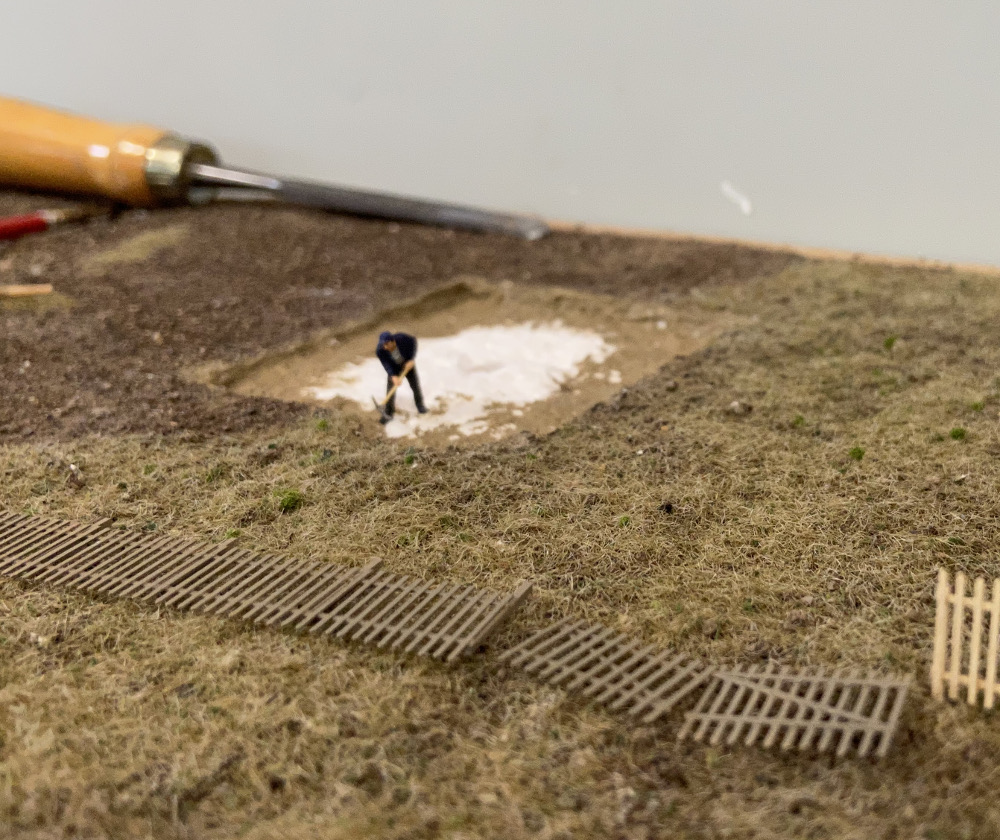
|
Re: What's on your workbench, January 2020?
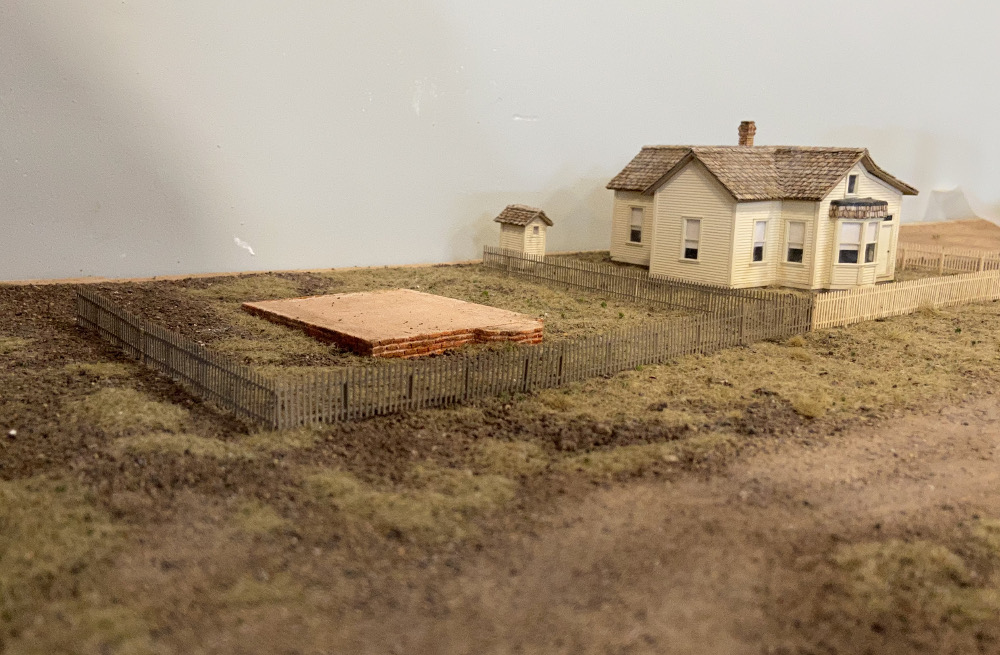
|
Re: What's on your workbench, January 2020?
|
Stunning. Your work is a real inspiration for what can be done in HOn3.
Dave Eggleston
Seattle, WA |
Re: What's on your workbench, January 2020?
|
Beautiful work, as always!!
Joe |
Re: What's on your workbench, January 2020?
|
Jeff,
The fence framing the foundation of the house under construction suggests life and a story in progress. Your ability to frame scenes that tell a story is an compliment to your excellent model building skills. I learn much from your scenes and models. Thanks for sharing. Lee Gustafson |
Re: What's on your workbench, January 2020? Early Cooke 2-6-0 paint schemes
|
In reply to this post by Jim Courtney
Paint chips I sampled from with a razor blade from the top of 9's steam done and boiler jacket in 2004 relvealed 5 layers of "paint". Unfortunately I have not found the tiny Ziploc bag of this sample ( in my storage I hope) to image a proof of the first layer was green, like faded light olive but not drab green, although perhaps with serious oxidation. Second was drop black as described a drop of blue in black. Sort of gray-blue- black. But not lamp black. Third layer; black- black. Fourth layer; black-black. Fifth layer; Chinese Red. I fear in 2005 Marlin Ullrich under contract with the Colorado historical society sand-blasted this evidence into eturnity for whatever that was worth. Anyhow I believe that after the rebuildings of the at the early days of the C&S, the sheet steel boilers jackets/ tops and bottoms of the domes were finished olive green.
|
Re: What's on your workbench, January 2020? Early Cooke 2-6-0 paint schemes
|
Thank goodness that you got that much Jeff,
Yes, sandblasting does a lot of harm for the serious historian or ferroarchaeologist. When I repainted 71 in 1970 back to its C&S configuration, I used paint stripper and took my time. Yes, I found the Gold lettering. I did not find a variation in paint that you found, even when I removed the Steam Dome to look. I inquired of the Boulder Model Railroad Club what they found on 60 when they repainted it and they told me that they used a sandblaster. Rick |
Re: What's on your workbench, January 2020? Early Cooke 2-6-0 paint schemes
I was there for all of the BMRC work sessions on #60 in 1982, and there was no sandblasting, just manual scraping where needed and washing with Mike Trent's hotsy:  IIRC, the oldest remnants we found were lettering remains from when it said IDAHO SPRINGS ELEV. 7540 from the 1940s. It's possible that someone concluded that it had been sandblasted back then to explain the lack of earlier lettering, or that somebody remembered the hotsy and thought it was a sandblaster. This photo shows Sam Schreiner applying the final black paint over the tender, where most of the previous paint was still in place, except where more intense scraping was needed to get rid of the residue of the Burlington herald sticker. 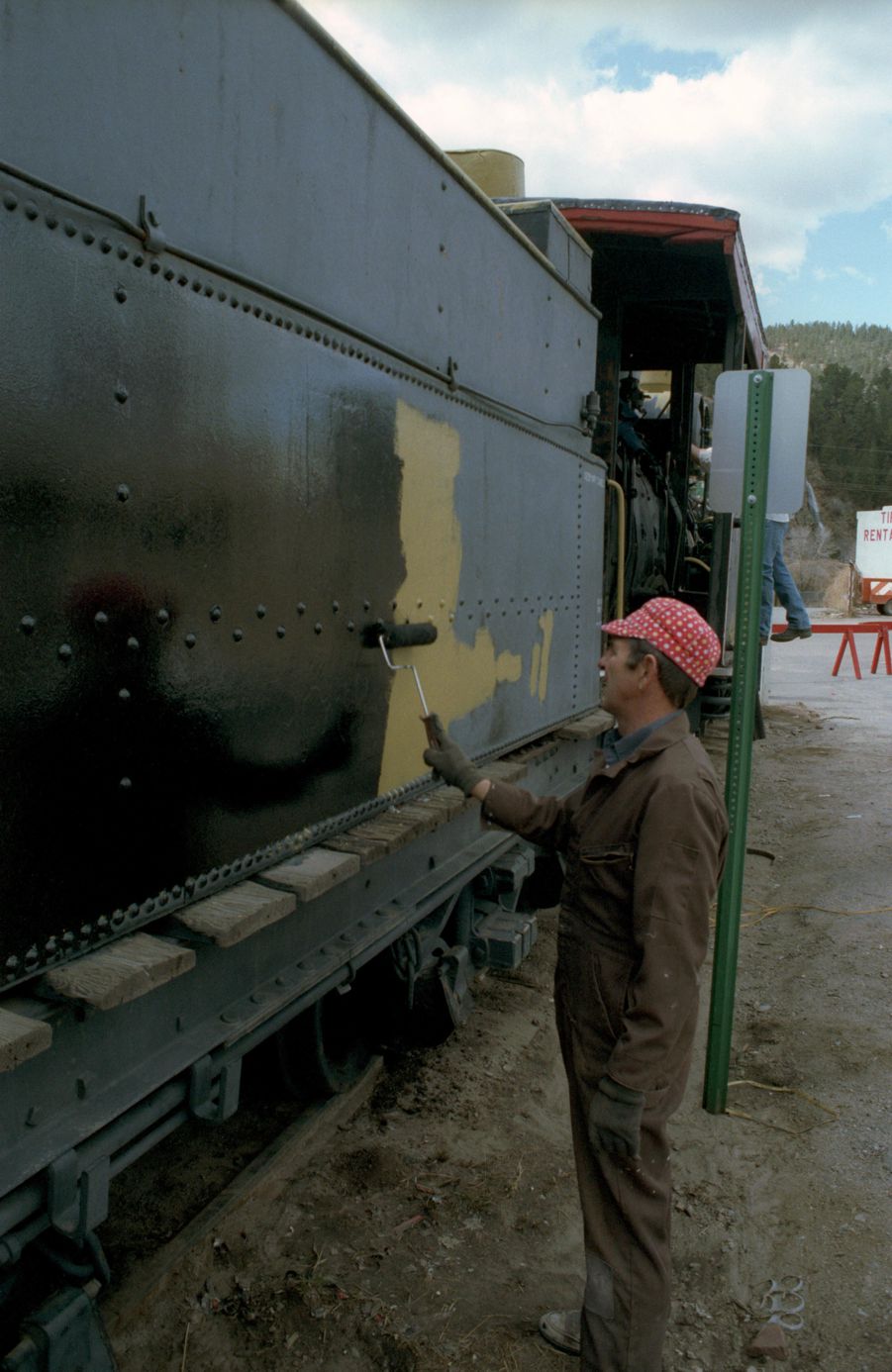 It was next painted sometime after the move (which was in 1987) by Mike Horner using mostly local help. I saw it after they had done most of the prep work but before applying the new paint, and I remember seeing some new sheet metal on the boiler jacket to cover areas that rotted out, but even that was just placed over the original, and paint was only scraped where needed. |
Re: What's on your workbench, January 2020? Early Cooke 2-6-0 paint schemes
|
Even after all these years, thanks for the correction Todd, I appreciate it. Since you were there, did you scrape down on the metal cab side any deeper than the Q decals that were placed there?
I didn't have the luxury of a hotsy. I had kleen-strip and a putty knife. Rick |
«
Return to C&Sng Discussion Forum
|
1 view|%1 views
| Free forum by Nabble | Edit this page |

